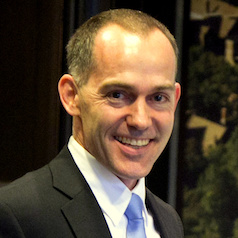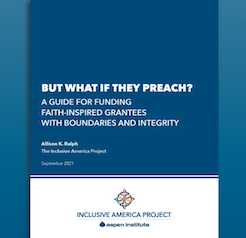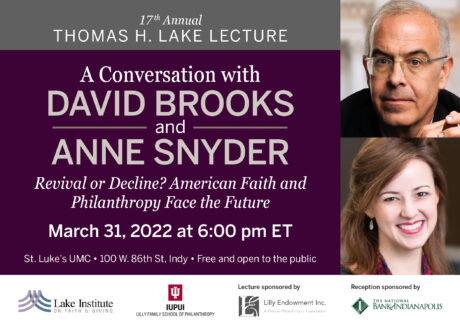But What if They Preach?
But What if They Preach?
 Our guest writer is Allison Ralph, Ph.D., associate director of the Religion & Society Program at the Aspen Institute.
Our guest writer is Allison Ralph, Ph.D., associate director of the Religion & Society Program at the Aspen Institute.
Unpacking Funder Questions and Concerns About Faith-Inspired Grantees
Relationships can be sticky for any number of reasons, but religion is different. Religion is often taboo, is increasingly polarized, and is deeply personal and weighted down with the baggage of individual and collective hurts. The field of institutional philanthropy tends toward a secular identity for historical and social reasons. For all these reasons, funders tend to be particularly squeamish about religion.
That squeamishness has a cost. Faith-inspired grantees make up between 35 – 40% of the nonprofit sector,1 and religion-related issues hold the keys to real results in reducing polarization,2 increasing civic engagement (PACE FIAD), and creating greater impact in issue areas funders care deeply about (Bridgespan). In some cases, faith-inspired organizations are the only way to reach specific populations.3
Resources for Funders
There are a few resources for funders to learn how to address this topic. A few collaboratives offer meaningful, low-risk entry points. Check out: Philanthropy for Active Civic Engagement’s Faith In/And Democracy Fund, the New Pluralists, and the Community Collaboration Initiative. My own Religious Pluralism Funders Circle offers an open space for peer discussion, and we are working with foundation member associations to offer topical programming at conferences. A first step is to check out my guide on this topic, But What If They Preach. There, I walk through some of the most common, and perfectly reasonable, concerns that funders have about faith-inspired organizations’ practices:
- Exclusions around target audiences or in hiring
- Mixing worship with work or volunteer activities
- Proselytizing to target audience
- General differences in social stances
- Financial accountability
Some funders turn down grantees on the mere uninvestigated suspicion of such practices. Too bad, too. Because funders miss out on impact, grantees on vital funding, and the target audience on needed services. What a cost! So, before counting these organizations out, funders should thoroughly understand their own concerns, ask open questions about a potential grantee’s practices, and then perform a cost-benefit analysis on the partnership.
Here, I’ll walk through an example cost-benefit analysis where the funder and grantee have strong mission alignment. I’ve anonymized a real grantee and entirely invented a funder.
A Cost-Benefit Analysis
The Florentine Nuns for Climate Action, whose mission is “Pursuing the common good for our common home,” is institutionally tied to this (made up) Catholic order. They organize globally around the integrity of creation, a.k.a climate justice. They are wildly effective at getting conservative Catholics to change their personal resource use and voting habits, and because they are a multiracial organization, they are attentive to intersectional concerns about climate and racism. The following four realities make some potential funders a bit hesitant:
- Only vowed nuns are promoted to leadership positions.
- They incorporate prayer and scripture into their public programming for a Catholic audience.
- They don’t file 990s because their project sits institutionally under a Catholic order, qualifying as a “church” for tax purposes.
- Their work on climate justice springs from the doctrine that all life is sacred, and the same doctrine designates gay marriage as sinful.
The Blue Boat Foundation’s mission is to mitigate climate change as quickly as possible. They strive for innovative, data-driven solutions. Internally, they identify as a progressive organization and are skeptical about religion in general. They view the Nuns’ discriminatory promotion practices and stances on a variety of social issues as problematic and even as a reputational risk with other progressive partners.
But, avoiding the Nuns would come at a real cost to Blue Boat’s impact because the Nuns successfully reach theologically conservative Catholics whose behavior change is ultimately necessary to Blue Boat’s cause. The Nuns are persuasive to this audience precisely because both the nonprofit and its audience genuinely share a theologically conservative view of the sanctity of life, which climate change endangers. The Florentine Nuns for Climate Action are not successful despite their faith, but because of it.
Taking a Deeper Look
Being data-driven, Blue Boat decides to get some more information on the Nuns’ actual practices.
- On discriminatory hiring – Blue Boat finds the Nuns do not restrict hiring at the entry level on any basis, but promotion is discriminatory because vowed nuns are preferred in middle and required at senior levels. Though Blue Boat doesn’t love this practice, they find it isn’t a deal-breaker.
- Where Blue Boat strongly dislikes proselytizing (preaching for conversion), they find the Nuns’ actual practice has no room for proselytizing; their audience is already Catholic.
- Although the Nuns don’t file 990s, they do provide externally audited financials.
- The Nuns proudly show clear data on their success in creating behavior change, which shows Blue Boat the potential benefit of the partnership. Blue Boat’s biggest hesitation is the difference in stances on other social issues: the Florentine Nuns for Climate Action believe holistically in the right-to-life, and Catholic doctrine disapproves of gay marriage. On inquiring whether any of the Nuns’ programming is directed at either anti-abortion or anti-marriage equality organizing, the answer is no.
Data in hand, Blue Boat reviews their own value priorities. Since proselytizing is not an issue, and the Nuns submit audited financials, the values conflict comes down to restrictive promotion practices and the general aura of conservative social values.
Blue Boat recognizes that climate change mitigation will require behavior change on the part of socially conservative individuals, and the Nuns’ genuinely conservative social stances are the reason they are successful with this audience. The benefit is the incredible impact in climate change reduction. The cost is partnership across very polarized issues and potential reputational risk with progressive partners.
Alignment Between Funder and Grantee
Blue Boat Foundation prioritizes their mission and commitment to data-driven decision making; they fund a project with the Florentine Nuns for Climate Action. They also take care to write conditions into the grant agreement that address their concerns: they require audited financial reporting, an agreement not to proselytize and an agreed definition of that term, and an agreement not to use funds for any other purpose than the proposed project.
Blue Boat can now show their willingness to partner across these lines as a proof of their commitment to the cause and to data-driven results, mitigating reputational risk among other progressive funders.
This example illustrates that by interrogating concerns more substantially, opening up avenues of dialogue, and communicating organizational values during the grantmaking process, funders may feel better equipped to capitalize on critical opportunities to partner with faith-inspired organizations and ultimately advance their own mission.
1Ressler, R., Fulton, B. R., & Paxton, P. (2020). Activity and identity: Uncovering multiple institutional logics in the nonprofit sector Paper presented at the Association for Research on Nonprofit Organizations and Voluntary Action Annual Meeting (virtual).
2Robert Wuthnow, Why Religion Is Good for American Democracy (Princeton and Oxford: Princeton University Press, 2021), https://press.princeton.edu/books/hardcover/9780691222639/why-religion-is-good-for-american-democracy.
3Loskota, Brie. 2019. “Bridging Religious Divides: Understanding the Influence of Faith and Religion on Social Strength and Civic Engagement.” Presentation at Council on Foundations Annual Meeting.
 Allison Ralph, Ph.D., is the Associate Director of the Religion & Society Program at the Aspen Institute. Her current research interests include understanding faith-inspired nonprofits, religious literacy and religion and philanthropy. Allison works at the intersection of religion and society in an effort to better understand ways we include or exclude on the basis of religious difference, and to radically expand inclusion.
Allison Ralph, Ph.D., is the Associate Director of the Religion & Society Program at the Aspen Institute. Her current research interests include understanding faith-inspired nonprofits, religious literacy and religion and philanthropy. Allison works at the intersection of religion and society in an effort to better understand ways we include or exclude on the basis of religious difference, and to radically expand inclusion.
Questions for Reflection
- Has your faith-inspired organization sought philanthropic funding? How might Ralph’s guide help you prepare to ask for that funding?
- Are you a funder? What insights did you gain from Ralph’s example and how might you use those insights for future funding alignment?
Expanded Perspective
 Religious Organizations and the U.S. Nonprofit Sector
Religious Organizations and the U.S. Nonprofit Sector
by Brad R. Fulton, Ph.D.
Religious organizations are among the oldest and most influential institutions in the world, and they are a significant and pervasive component of the U.S. nonprofit sector.
Religious organizations receive more charitable dollars than any other category of nonprofit organization—nearly one-third of all charitable dollars (Giving USA, 2021). They also mobilize more volunteers than any other type of nonprofit: three-fourths of adult volunteers regularly attend religious services, and one-third of adult volunteers learn about service opportunities through their congregation (Grønbjerg & Never, 2004; Urban Institute, 2004). Religious organizations are also the most prevalent type of organization in the nonprofit sector, encompassing not only congregations but also a wide variety of other faith-based organizations that provide a vast array of products and services. They operate in every major domain of the nonprofit sector and range from religious media companies to faith-based prisons to “creation care” environmental movements and Christian biker clubs.
Recent research indicates that that there are approximately 177,000 religiously-identified organizations operating in the non-religious domains of the nonprofit sector (Ressler et al., 2020). This estimate does not include the approximately 384,000 religious congregations in the U.S. (Brauer, 2017), or the approximately 109,000 religious nonprofit organizations that are not congregations but whose primary activity is promoting religion (Scheitle, 2010). Together, these estimates indicate that there are approximately 670,000 religious nonprofits in the U.S.
Given the scale and pervasiveness of religious organizations in the nonprofit sector, it is critical to understand what characterizes these organizations, how they are different from and similar to secular nonprofit organizations, and how religion influences the nonprofit sector more broadly. However, nonprofit scholars have dedicated relatively little attention to religious organizations and still less to religion within the nonprofit sector. As a result, little is known about the impact of religion and religious affiliation on nonprofits’ characteristics, practices, and outcomes.
It is also imperative to critically examine the assumed dichotomy between religious and secular nonprofits. The role of religion in the nonprofit sector is relevant to not only religious organizations but also secular organizations that incorporate religious elements or include faith-oriented participants. At the same time, some religious organizations operating in non-religious domains of the nonprofit sector downplay their religious affiliation, making them functionally indistinguishable from their secular counterparts. In contrast, some religious organizations differentiate themselves from their secular counterparts by adopting an explicitly religious identity and incorporating religious practices into their activities. Despite the substantial overlap in activities and wide variation in approaches to religion, attempts to discern differences and similarities between religious and secular organizations and to understand how religion impacts the nonprofit sector have been inhibited by the dearth of research on religious organizations and religion within nonprofit and organizational scholarship.
Addressing the topic of religion and philanthropy can not only generate insights about the field of religious nonprofits, but also lead to greater understanding of the nonprofit sector as a whole.
Brad R. Fulton is an associate professor of nonprofit management in the O’Neill School at Indiana University. He is director of the Faith & Prejudice Institute, co-director of the National Study of Congregations’ Economic Practices, and a fellow with the Aspen Institute’s Religion & Society Program.
 The Religion & Society Program (formerly the Inclusive America Project) at Aspen Institute and Allison K. Ralph offer this brief guide for funders on how to partner with faith-inspired grantees with clear boundaries and integrity. It is designed for both funders new to the space, and those who would like to improve their working relationships with current faith-inspired grantees. The hope is that this guide might provide new tools to funders and encourage them to consider more faith-inspired organizations as potential partners.
The Religion & Society Program (formerly the Inclusive America Project) at Aspen Institute and Allison K. Ralph offer this brief guide for funders on how to partner with faith-inspired grantees with clear boundaries and integrity. It is designed for both funders new to the space, and those who would like to improve their working relationships with current faith-inspired grantees. The hope is that this guide might provide new tools to funders and encourage them to consider more faith-inspired organizations as potential partners.
But What if They Preach
 The Religion & Society Program (formerly the Inclusive America Project) at Aspen Institute and Allison K. Ralph offer this brief guide for funders on how to partner with faith-inspired grantees with clear boundaries and integrity. It is designed for both funders new to the space, and those who would like to improve their working relationships with current faith-inspired grantees. The hope is that this guide might provide new tools to funders and encourage them to consider more faith-inspired organizations as potential partners.
The Religion & Society Program (formerly the Inclusive America Project) at Aspen Institute and Allison K. Ralph offer this brief guide for funders on how to partner with faith-inspired grantees with clear boundaries and integrity. It is designed for both funders new to the space, and those who would like to improve their working relationships with current faith-inspired grantees. The hope is that this guide might provide new tools to funders and encourage them to consider more faith-inspired organizations as potential partners.
Thomas H. Lake Lecture PDFs
 In addition to the replay of our Thomas H. Lake Lecture from March 31, 2022, we now have PDFs available. You can access the transcripts from both Anne Snyder and David Brooks’ remarks on Revival or Decline? American Faith and Philanthropy Face the Future.
In addition to the replay of our Thomas H. Lake Lecture from March 31, 2022, we now have PDFs available. You can access the transcripts from both Anne Snyder and David Brooks’ remarks on Revival or Decline? American Faith and Philanthropy Face the Future.
Subscribe
Insights, a bi-weekly e-newsletter, is a resource for the religious community and fundraisers of faith-based organizations that provides:
- Reflections on important developments in the field of faith and giving
- Recommended books, studies and articles
- Upcoming Lake Institute events
